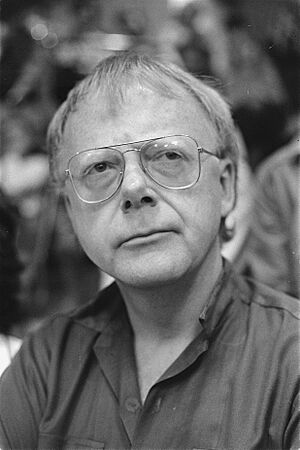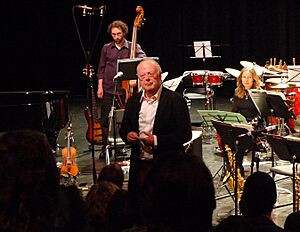Louis Andriessen facts for kids
Quick facts for kids
Louis Andriessen
|
|
|---|---|

Andriessen in 1983
|
|
| Born | 6 June 1939 Utrecht, Netherlands
|
| Died | 1 July 2021 (aged 82) Weesp, Netherlands
|
| Education | Royal Conservatory of The Hague |
| Occupation |
|
| Organization |
|
| Spouse(s) |
Jeanette Yanikian
(m. 1996; died 2008)Monica Germino
(m. 2012) |
| Awards |
|
Louis Joseph Andriessen (born June 6, 1939 – died July 1, 2021) was a famous Dutch composer, pianist, and teacher. Many people thought he was the most important Dutch composer of his time. He was a key figure in a group of composers called The Hague school.
At first, his music sounded like older styles, but he slowly started mixing new ideas. He combined American minimalist music, jazz, and the style of Igor Stravinsky. Andriessen taught at the Royal Conservatory of The Hague for many years. His opera La Commedia, which was based on Dante's Divine Comedy, won a big award in 2011. Critics also named it one of the best musical works of the 21st century.
Contents
Louis Andriessen: A Modern Composer
Louis Andriessen was born in Utrecht, Netherlands, on June 6, 1939. He came from a very musical family. His father, Hendrik Andriessen, was also a composer and a professor. Louis studied music with his father and other famous composers like Kees van Baaren and Luciano Berio.
He started writing for newspapers and magazines in the 1960s. In 1965, he moved to Amsterdam.
A Composer Who Challenged the Rules
In 1969, Andriessen and a group of friends caused a stir at a concert. They used noisemakers to protest that Dutch orchestras weren't playing enough new music. This protest, known as the "Nutcrackers" incident, led to them being briefly jailed. However, it also helped bring about changes in the Dutch music world.
Andriessen became known around the world with his 1976 piece, De Staat. This work used words from Plato's famous book, Republic. He was one of the people who started the Hague School. This was a new movement that focused on minimalist and modern music.
Later in his career, big orchestras like the San Francisco Symphony and the New York Philharmonic asked him to write music for them. Festivals in cities like London, Tokyo, and New York celebrated his work.
Working with Music Groups

In 1969, Andriessen helped create a studio for electronic music called STEIM in Amsterdam. He also helped start music groups like Orkest de Volharding and Hoketus. These groups were different from traditional orchestras. They included musicians who played classical, jazz, and pop music. He also worked closely with the Schonberg and Asko ensembles and inspired the British group Icebreaker.
Teaching Future Composers
Andriessen started teaching at the Royal Conservatory in 1974. He taught composition there until 2012. He had a big impact on many students who became famous composers themselves, such as Michel van der Aa and Steve Martland. He also gave talks at well-known universities like Yale University and Princeton. In 2004, he became a professor at the University of Leiden.
His Personal Life
Louis Andriessen was married to guitarist Jeanette Yanikian for many years. His opera La Commedia is dedicated to her. Later, he married violinist Monica Germino. She announced in 2020 that he was suffering from dementia. Louis Andriessen passed away on July 1, 2021, at the age of 82. He had one son, Lodewijk, with dancer Betsy Torenbos.
His Unique Musical Style
Andriessen's music changed a lot over time. He started with a very simple, old-fashioned style, then moved to a more strict, mathematical way of composing. His early works showed him trying out different new ideas in music.
He didn't like how traditional many Dutch music groups were. So, he decided to create his own unique sound. From the 1970s, he stopped writing for regular symphony orchestras. Instead, he wrote for his own special groups of instruments. These often included traditional instruments mixed with electric guitars, electric basses, and conga drums.
Andriessen often used his music to share political ideas. He also found inspiration in art and philosophy. His ideas came from many places, like the music of Charles Ives, the art of Piet Mondrian, and old poems.
Famous Works and Collaborations
Andriessen's later music is a special mix of American sounds and European styles. It combines jazz, American minimalism, and the influences of composers like Igor Stravinsky. His music often has repeating rhythms, short melodies, and harmonies that can be both smooth and sharp. By the 21st century, he was seen as Europe's most important minimalist composer.
Some of his most famous works include:
- Workers Union (1975): A piece for "any loud sounding group of instruments." It tells musicians what rhythm and shape to play, but not the exact notes.
- De Tijd (Time, 1979–81): For female singers and an ensemble.
- De Materie (Matter, 1984–88): A large four-part work for voices and instruments.
- He worked with filmmaker Peter Greenaway on the film M is for Man, Music, Mozart and the operas Rosa: A Horse Drama (1994) and Writing to Vermeer (1998).
- His opera La Commedia (2004–08), based on Dante's Divine Comedy, is very well-known. It won the 2011 Grawemeyer Award for Music Composition and was chosen as one of the best compositions of the 21st century by The Guardian newspaper.
Awards and Recognition
Louis Andriessen received many awards and honors throughout his career:
- 1959 Gaudeamus International Composers Award
- 1977 Matthijs Vermeulen Award for De Staat
- 1977 UNESCO International Rostrum of Composers in Paris
- 1993 Edison Award
- 2011 Grawemeyer Award for Music Composition for La Commedia
- 2016 Marie-Josée Kravis Prize for New Music
- He also received honorary doctorates from Birmingham City University (2010) and the University of Amsterdam (2019).
Works
Louis Andriessen's music was mainly published by Boosey & Hawkes and Donemus. Some of his important works include:
- Rondo Barbaro (1954) for piano
- Séries (1958) for 2 pianos
- Anachronie I (1966–67) for large orchestra
- Reconstructie (1969) – an opera he co-wrote
- Workers Union (1975) for any loud-sounding group of instruments
- De Staat (1972–76) for voices and instruments
- Hoketus (1975–76) for a special group of instruments
- Mausoleum (1979) for voices and orchestra
- De Tijd (Time, 1979–81) for female chorus and orchestra
- De Snelheid (Velocity, 1982–83) for three amplified ensembles
- De Materie (Matter, 1984–88) a large four-part work
- M is for Man, Music, Mozart (1991) for film
- Rosa – A Horse Drama: The Death of a Composer (1993–94) an opera
- Writing to Vermeer (1997–99) an opera
- La Passione (2000–02) for female jazz voice, violin and ensemble
- La Commedia (2004–08) a film opera
- Mysteriën (2013) for orchestra
- Theatre of the World (2013–15) a 'grotesque stagework'
- The Only One (2018) a song cycle

